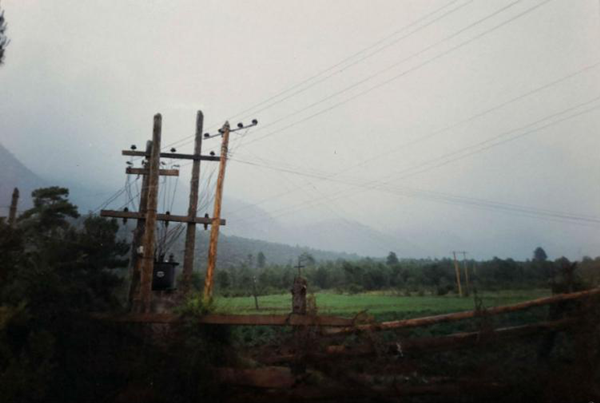An Old Friend for Half a Century
Larong was born in 1952 in a little Tibetan village called Jiaorong, located in Napahai wetland of Shangri-La of Diqing Tibetan Autonomous Prefecture in Yunnan Province. This little distant village he called his hometown is part of the grassland of Napahai.
Twenty-five years ago, Larong joined the CPC, and became the head of the local militiaman platoon.
He recalled that when he was a kid, his family of five lived in a simple adobe house of only a dozen square meters. They ate dough made of buckwheat and potato, and were allocated a bit of meat only during Spring Festival. His family was so poor that they could not afford shoes or trousers.
Larong did not have trousers until he was eight. In his village, everyone was living in extreme poverty and none of them had seen rice in their entire life, as rice had to be obtained through exchange in other cities such as Dali or Baoshan for barley and potatoes harvested locally. It was a long trip and a lot of food was spoiledeven before arrival.
It was not until he was 23 that his family built a wooden house. But there was no electricity. They had to sit around the dim butter lamp at night. However, everything changed in the village in the 1970s when a transformer was installed.
The 100-kVA transformer, made in 1962, had certainly seen some years of use. Back then, the whole prefecture only had three transformers, which were all bought by a local militiaman hero Qilin Wangdan, known as the "Snow Mountain Eagle", for his hometown. The head of the village cooperative, along with an accountant and storeman, offered one of the keepers of the three transformers 40 yaks and horses in exchange for the transformer and its wires.

Transformer produced by the state-owned Kunming Electrical Machinery Plant in 1962 [Photo/sasac.gov.cn]

Transformer in service before upgrading [Photo/sasac.gov.cn]
In the eyes of local people at that time, the transformer was sort of high technology. A huge crowd of people were attracted when it was installed in the village. The local electricity bureau sent three technicians to work on the installation, accompanied by more than 20 men sent by the village in three teams. Larong was on one of the teams.
According to Larong, lumber used on the poles was carried from the mountains by yaks. Thrilled to hear from the technicians that the nights would be as bright as days when the transformer was installed, they worked day and night to complete the task in only six days.
He recalled the moment the village had electricity for the first time ever. Everyone was delighted and curious seeing the lit bulbs. Electricity was like magic to many of them who had previously used only butter lamps. Larong said that he wondered for a whole month where the electricity was from. After consulting with many people, he found out that the source was a hydropower station.
Thanks to the transformer, villagers started to see some good changes in their lives. Especially after 1978, everyone's life began to change for the better. They had their own farm land for highland barley and started to breed their own pigs and cattle. Local households had more meat on their dining table and gradually replaced butter lamps with electric lights.
With a stable power supply, life was made much easier for the locals. To prepare buttered tea, it used to take a full day to make butter by hand in a basket. Now it takes just a few minutes with a stainless electric separator.

Old-fashioned tools for buttered tea preparation [Photo/sasac.gov.cn]
According to Larong, the transformer had a history of perfect trouble-free operation for half a century - not even a screw was changed. "Thanks to low temperature and working-loads, it is not a problem for an oil-immersed three-winding transformer like this one to work for 80 years," said Kelsang Tenzin, deputy head of the local power supply station.
Despite its long endurance, he had some concerns about the transformer. As its oil needed to be changed every year, the operational cost and deterioration were high. In consideration of this, he advised the village committee many times to consider a replacement transformer. But everyone was emotionally attached to the old one after many years of great service so his requests were all turned down.
In 2009, Kelsang Tenzin brought up the request again. At that time, an overall reform of the grids was about to be launched in Diqing Tibetan Autonomous Prefecture to realize alignment between urban and rural grids. The prefecture power supply company had been assigned to Yunnan Power Grid Corporation under the China Southern Power Grid, in line with reform requirements of national power system reform.
Taking this opportunity, Kelsang Tenzin advised the village to upgrade the power frame and transformer altogether. But locals were again reluctant to let go of the transformer and only agreed on the line change. After two rounds of rural grid upgrading, the overall power system in Jiaorong village, including lines, poles and meters, was all upgraded, except for the old transformer.
A lot of efforts were made by Kelsang Tenzin and his colleagues to ensure their old friend to not break down. In special weather conditions, he and his teams would conduct equipment inspections. Larong recalled that Kelsang Tenzin and a repairer came to the village in a snow storm in February 2017 in order to clear faults along the lines so power would not be lost in the snow.
Out of some security and reliability concerns, the transformer was finallyreplaced on Aug 14, 2018. According to local power station staff, the grid system for the entire prefecture has been further upgraded. Since 2009, Yunnan Power Grid Corporation has invested 797 million yuan ($112.32 million) in Diqing prefecture on installation and renovation of 1,696.64 kilometers of lines that are 20 kV and below and installed 1,037 transformers. Jiaorong village was one of the beneficiaries.
Even after its retirement, villagers talked about how their transformer had helped them over the years.

Rural grid system upgrade [Photo/sasac.gov.cn]
Jiaorong village now has 53 households and a population of 313. With completion of infrastructure projects on water, electricity, and roads, the village has been engaged in rural tourism as it sits adjacent to the Napahai natural reserve. Many villagers have started their own family inns and travel businesses. Households now have TVs, fridges, electric cookers, and even electric lights on shrines.

Kelsang Tenzin on one of his transformer inspection tours after the rural grid upgrade [Photo/sasac.gov.cn]
As the local tourism flourished, villagers diversified their income sources and invested money to renovate or rebuild properties that have water, electricity and road accessibility. As people became richer, they began working on preserving the local natural environment. All of this has something to do with the first transformer ever installed in the village.
The old transformer is still kept in the village functional room by the villagers. Larong said he often visits it after returning from work. To him, the transformer is an old friend.
(Executive editor: Zhang Tianyuan)



